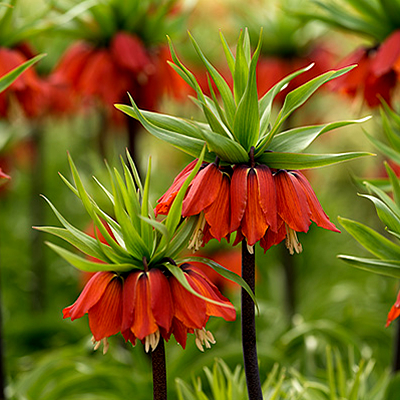Spring Fling with Fritillaries
/Historically known as "the crown imperial", but jokingly referred to as "the Dr. Seuss Flower" by members of my garden club, Fritillaria is a sight to behold in the spring garden. All 45 members of my garden club were given a bulb to plant 3 years ago, so that we could try it and compare notes. We were all surprised and delighted by this unusual spring bulb.
There are more than 200 forms of fritillaria in the world, many of them rare alpine plants. They are popular in the UK, home of the Fritillaria Society, and of garden estates that host Frittillary Weekends. Vita Sackville-West described the fritillary as looking like something exceedingly choice and expensive, but added it was “a sinister little flower, in the mournful colours of decay”. She was referring to Fritillaria meleagris, also known as snake’s head lily, leper lily, chess or guinea flower, with pendant bells in white, purple or pink checks hanging from gray grassy stems. Despite their sinister common names, checkered lilies are charming little flowers (12" - 15" tall) native to damp meadows and woodlands in Europe. They require partial shade and abundant moisture, and are an excellent choice for naturalizing. I will never forget my first encounter with them naturalized in a lawn at Chanticleer Garden - it was a magical sight!
Fritillaria meleagris - White Flower Farm
Another charming Fritillary is Fritillaria michailovski, or Michael's Flower, which is native to Turkey. Its nodding bell-shaped deep burgundy blossoms are brightly tipped in glowing yellow on arched branches. Michael's Flower looks great in a pot as well as in the garden.
Fritillaria persica, or Persian Fritillaria, sports narrow 30" stalks of deep purple-black bell-shaped blossoms with gold centers and gray-green foliage. It grows in full sun to part shade, and complements dark maroon tulips.
Fritillaria persica at Avant Gardens
Spring garden with Fritillaria persica at Chanticleer
Tall and aristocratic looking, the crown imperial looks down on the world from its 3 foot height, usually in shades of yellow, orange and scarlet. Its bell-shaped flowers on strong stalks are "crowned" with another burst of green foliage that sits majestically atop the pendulous blooms. It prefers a sunny, well-drained soil, and attracts butterflies.
Scarlet Crown Imperial from Phoenix Perennials
A new variegated fritillary called Aureomarginata emerges in spring with twisted green and yellow foliage, a smoky flower stalk and bright orange flowers crowned with spidery green leaves. It is both surprising and whimsical.
Fritillaria imperialis Aureomarginata from Bluestone Perennials
Fritillaries are members of the lily family, and their name is derived from the Latin term for a dice box (fritillus) which probably refers to the checkered pattern of the flowers. Fritillaries do not like to be disturbed after planting, so they are not ideal for containers. Crown Imperials should no be cut for vases, because that would reduce their stems too much and would weaken the plant. They also have a slight odor, which does not make them welcome indoors, but repels deer, rabbits and voles. As with other spring bulbs, the foliage should be left standing until it yellows, so that the plant can photosynthesize and store carbohydrate reserves for its dormancy.
You Might Also Like


















